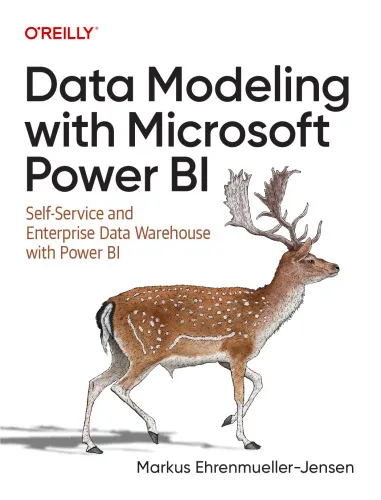Data Modeling with Microsoft Power BI: Self-Service and Enterprise Data Warehouses with Power BI
4.6
Reviews from our users

You Can Ask your questions from this book's AI after Login
Each download or ask from book AI costs 2 points. To earn more free points, please visit the Points Guide Page and complete some valuable actions.Analytical Summary
"Data Modeling with Microsoft Power BI: Self-Service and Enterprise Data Warehouses with Power BI" is a specialized, advanced guide designed for professionals, academics, and serious data practitioners. Written with an authoritative yet approachable style, the book fulfills a critical gap in the literature—explaining not only how to use Power BI effectively but also how to design robust data models that serve both self-service analytics and large-scale enterprise systems.
The text dives deeply into the principles and practices of data modeling within the Power BI ecosystem. Readers gain a thorough understanding of concepts such as star schemas, normalization, relationship management, calculated columns, measures, and hierarchies—all framed in the context of Microsoft's powerful BI platform. There is a sustained emphasis on using modeling to drive better performance, usability, and scalability.
The primary keyword—Data Modeling with Microsoft Power BI: Self-Service and Enterprise Data Warehouses with Power BI—is woven into discussions where concepts meet practical application. The secondary keywords, "Power BI data modeling" and "enterprise BI architecture," find natural integration as the work assesses how well-designed models promote insight generation and organizational intelligence across diverse industries.
While Information unavailable regarding first publication date due to no reliable public source, the content possesses enduring relevance in the rapidly evolving BI landscape. The book stands out for its clear differentiation between self-service capabilities aimed at data-savvy end users and enterprise-level provisions supporting governance, security, and structured workflows.
Key Takeaways
Readers acquire a skillset that blends conceptual mastery with hands-on technical fluency, enabling them to shape Power BI models that deliver actionable insight at scale.
Identify common patterns in transforming raw data into optimized models that enhance computational efficiency and visualization clarity.
Learn how self-service BI can empower teams without compromising data governance, aligning with the core theme of balancing autonomy with control.
Understand the principles of enterprise BI architecture, including integration with data warehouses, ETL strategies, and cross-platform compatibility.
Apply advanced DAX techniques to create measures that unlock complex KPIs and analytical perspectives.
Develop a holistic view of how modeling decisions influence performance, adoption, and organizational analytics maturity.
Memorable Quotes
"Good data modeling is the backbone of effective analytics—without it, even the best tools struggle to deliver value." Unknown
"There is no substitute for thoughtful architecture when bridging self-service and enterprise BI." Unknown
"Power BI’s flexibility shines brightest when models are crafted with both present needs and future growth in mind." Unknown
Why This Book Matters
In an era where data-driven decisions shape competitive advantage, this book offers a roadmap for leveraging Power BI’s modeling capabilities to their fullest.
By addressing both self-service and enterprise contexts, "Data Modeling with Microsoft Power BI: Self-Service and Enterprise Data Warehouses with Power BI" equips readers to design systems that scale with demand and adapt to changing requirements. It bridges the gap between departmental agility and corporate governance.
For serious readers and practitioners, understanding how to construct well-structured data models is no longer optional—it is fundamental to delivering accurate, timely, and impactful analytics. This book’s dual focus provides the foundation for driving successful BI strategies in organizations of all sizes.
Inspiring Conclusion
"Data Modeling with Microsoft Power BI: Self-Service and Enterprise Data Warehouses with Power BI" stands as an authoritative companion for anyone committed to mastering the interplay between high-quality models and insightful analytics.
Whether you are architecting enterprise BI systems or enabling self-service capabilities for diverse teams, the principles within these pages will guide you toward robust, scalable, and future-ready solutions. The combination of theory, application, and strategy ensures a comprehensive approach to harnessing Power BI for transformative results.
The next step is yours: read, share, and discuss this work with colleagues and peers who understand the critical role of data modeling in modern business intelligence. By doing so, you will not only deepen your grasp of the subject but also contribute to a culture where informed analysis drives smarter decisions.
Free Direct Download
You Can Download this book after Login
Accessing books through legal platforms and public libraries not only supports the rights of authors and publishers but also contributes to the sustainability of reading culture. Before downloading, please take a moment to consider these options.
Find this book on other platforms:
WorldCat helps you find books in libraries worldwide.
See ratings, reviews, and discussions on Goodreads.
Find and buy rare or used books on AbeBooks.
1011
بازدید4.6
امتیاز50
نظر98%
رضایتReviews:
4.6
Based on 0 users review
"کیفیت چاپ عالی بود، خیلی راضیام"
Questions & Answers
Ask questions about this book or help others by answering
No questions yet. Be the first to ask!


